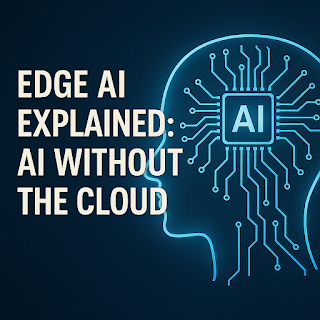Edge AI Explained: AI Without the Cloud
Artificial Intelligence has historically relied on the power of centralized cloud servers to process and analyze massive datasets. But a new revolution is underway—Edge AI—where intelligent algorithms operate directly on local devices, far from centralized data centers. From smartphones and wearables to industrial machines and self-driving cars, Edge AI is redefining the limits of speed, security, and autonomy.
This article explains what Edge AI is, how it works, and why it’s becoming critical for the future of AI and real-time computing.
📍 What Is Edge AI?
Edge AI refers to the deployment of artificial intelligence algorithms on edge devices, such as sensors, IoT devices, smartphones, and embedded systems, rather than relying on a cloud server or remote data center.
Instead of sending data to the cloud for processing, devices can:
-
Analyze data locally
-
Make decisions instantly
-
Operate with or without an internet connection
🔁 Edge AI vs Cloud AI
| Feature | Cloud AI | Edge AI |
|---|---|---|
| Location of Processing | Centralized (cloud/data center) | Decentralized (on device) |
| Latency | Higher (network-dependent) | Very Low |
| Internet Dependency | Required | Optional |
| Security Risk | Higher (data travels to server) | Lower (data stays local) |
| Energy & Bandwidth | Higher consumption | Lower usage |
Edge AI doesn’t replace cloud AI—it complements it by pushing critical decision-making closer to where data is generated.
🛠️ How Edge AI Works
Edge AI typically involves a lightweight AI model that is trained in the cloud and then deployed to an edge device. These devices are optimized to run inference (using a trained model to make predictions) without needing constant cloud access.
Key Components:
-
On-device inference engines (e.g., TensorFlow Lite, ONNX Runtime, Apple Core ML)
-
TinyML for ultra-low-power microcontrollers
-
Edge GPUs or NPUs for performance (e.g., NVIDIA Jetson, Google Coral)
Data is processed right at the point of origin—reducing the need for constant connectivity or large bandwidth.
🚀 Advantages of Edge AI
⚡ 1. Ultra-low Latency
No round trip to the cloud means near-instant responses. Crucial for:
-
Self-driving cars
-
Industrial robotics
-
Augmented reality (AR)
🔐 2. Enhanced Privacy & Security
Since data doesn't leave the device, privacy risks are significantly reduced. Ideal for:
-
Healthcare wearables
-
Smart home systems
-
Surveillance cameras
🌐 3. Offline Capability
Edge AI works even when there’s no internet:
-
Voice assistants in poor network zones
-
Agricultural drones in remote fields
-
Military and rescue equipment in disaster zones
📉 4. Reduced Bandwidth & Cost
By processing locally, edge devices don’t need to upload huge datasets to the cloud—saving bandwidth and lowering data center costs.
🔋 5. Energy Efficiency
Optimized models on energy-efficient hardware consume far less power—key for mobile and IoT deployments.
🧠 Real-World Applications of Edge AI
📱 Smartphones
-
Face unlock (Apple Face ID, Android biometrics)
-
Voice assistants (Google Assistant, Siri) with on-device processing
-
Photo enhancement and content filtering
🏭 Smart Factories (Industry 4.0)
-
Detecting faults in machinery using edge sensors
-
Predictive maintenance without cloud delays
-
Instant quality control via computer vision
🚗 Autonomous Vehicles
-
Real-time object detection
-
Lane tracking and emergency braking
-
No time to wait for cloud feedback in life-critical scenarios
🏠 Smart Homes
-
AI-powered cameras for intrusion detection
-
Energy management using AI thermostats
-
Personalized automation without exposing private data
⚕️ Healthcare
-
Real-time vitals monitoring with wearable AI
-
Fall detection for elderly care
-
On-device ECG analysis
🧩 Challenges of Edge AI
Despite its promise, Edge AI comes with technical and strategic challenges:
🧮 1. Model Compression and Optimization
AI models must be shrunk to fit on-device memory while maintaining accuracy. Techniques like quantization, pruning, and knowledge distillation are used.
📦 2. Hardware Constraints
Edge devices have limited CPU, memory, and battery. Specialized AI accelerators (e.g., NPUs) are required.
🔄 3. Model Updates
Deploying model updates remotely (known as over-the-air or OTA updates) is necessary to keep devices smart and secure.
🛡️ 4. Security of Firmware and Models
Models on edge devices can be reverse-engineered if not protected. Hardware-level encryption is essential.
🧠 Tools & Frameworks for Edge AI
-
TensorFlow Lite – lightweight ML for mobile & embedded devices
-
ONNX Runtime – Microsoft’s portable AI format for edge devices
-
Core ML – Apple’s on-device AI for iOS apps
-
Edge Impulse – Low-code edge ML platform for sensors & IoT
-
NVIDIA Jetson – High-performance edge computing for robotics & vision
🔮 Future of Edge AI
🔄 Federated Learning
Trains AI across decentralized devices without sharing raw data. Devices learn collectively while maintaining privacy.
🌎 5G + Edge AI
The low latency of 5G networks will further boost the potential of real-time edge intelligence.
💼 Enterprise Adoption
Expect sectors like agriculture, oil & gas, defense, and logistics to increasingly embrace Edge AI for real-time control, automation, and monitoring.
💡 Final Thoughts
Edge AI is shifting intelligence from the cloud to the point of data origin—making systems faster, safer, and smarter. It represents a powerful move toward more private, reliable, and scalable AI systems that operate in real-time, on any device.
As more industries and consumers demand instant, secure, and offline-capable solutions, Edge AI will become the backbone of next-generation AI infrastructure.
📘 Meta Description
Learn what Edge AI is, how it works, and why on-device intelligence is the future of artificial intelligence—faster, more private, and cloud-independent.
🔑 Keywords
Edge computing AI, edge AI, on-device AI, AI without the cloud, embedded AI, real-time AI, AI inference on device, Edge ML, TinyML, federated learning, AI hardware
🏷️ Tags
#EdgeAI #OnDeviceAI #EdgeComputing #AIHardware #TinyML #AIWithoutCloud #FederatedLearning #RealtimeAI #AIForIoT #AITrends #ArtificialIntelligence #AI2025
Other Reference Article




Comments
Post a Comment